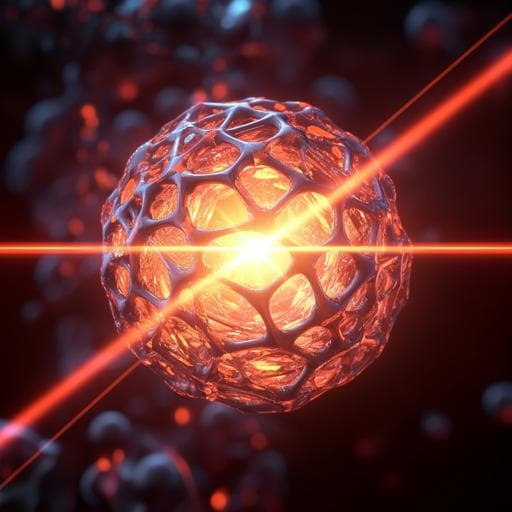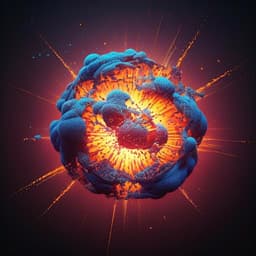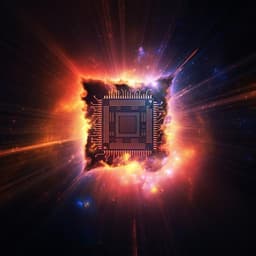
Physics
4th generation synchrotron source boosts crystalline imaging at the nanoscale
P. Li, M. Allain, et al.
Discover how 4th-generation synchrotron sources revolutionize coherent X-ray microscopy, significantly enhancing crystal microscopy's capability to unveil matter's 3D crystalline structures. This groundbreaking study, led by Peng Li and colleagues, demonstrates unprecedented imaging quality by leveraging increased coherent flux to overcome limitations faced by earlier generation sources.
~3 min • Beginner • English
Introduction
Fourth-generation synchrotron sources employ multi-bend achromat storage rings to deliver highly brilliant X-ray beams with drastically reduced source size and divergence, resulting in large gains in coherent flux (up to ~200× in the 6–10 keV range). This is transformative for coherent X-ray methods and, in particular, crystal microscopy techniques that require high coherence to image 3D crystalline structure and strain at the nanoscale. Traditional finite-support Bragg coherent diffraction imaging (BCDI) has yielded important results but is limited to isolated, finite-sized crystals and struggles with weak or highly inhomogeneous strain. Bragg ptychography extends applicability to laterally extended and inhomogeneous crystals by scanning a finite probe, but has been hampered by extreme sensitivity to instabilities, stringent positioning accuracy, and time-consuming acquisitions. The study investigates whether the increased coherent flux from a 4th-generation source enables robust, high-quality Bragg ptychography, mitigating experimental instabilities and relaxing constraints that have limited broader adoption, and contrasts this with the limits of 3rd-generation sources.
Literature Review
The authors review coherent diffractive imaging approaches that bypass the resolution limits of X-ray optics by numerically inverting coherent diffraction patterns. Finite-support Bragg coherent diffraction imaging (BCDI) has matured and produced impactful results across electrochemical, mechanical, and other environments, benefiting from relatively simple constraints but restricted to small, isolated crystals and challenged by weak/inhomogeneous strain retrieval. Bragg ptychography was proposed to overcome these limitations by scanning a finite probe with overlap to decompose the inversion problem, enabling imaging of extended crystals and complex strain/tilt fields. However, widespread success has been limited by sensitivity to sample/beam instabilities, the need for nanometric positioning accuracy during angular scans, and prolonged acquisitions. The emergence of 4th-generation synchrotrons with much higher coherent flux is expected to unlock these methods by improving signal quality and tolerance to experimental imperfections.
Methodology
Experiments were performed at the NanoMAX beamline (Max IV Laboratory, Sweden), a 4th-generation synchrotron facility. A 12 keV monochromatic beam was focused to ~80 nm FWHM (central lobe) at the sample, delivering ~6 × 10^9 photons·s^-1. The sample was a lithographically patterned crystalline Si-star test structure (diameter ~2 µm, 11 branches ~760 nm long, tapering to 55 nm near the center, nominal thickness 180 nm, with Si-(110) normal to the surface). The 220 Bragg reflection was used. Data were acquired in Bragg ptychography mode with a combined spatial and angular scan: continuous fly-scan along y (perpendicular to the scattering plane) and step-scan along x (in the scattering plane), repeated over several sample rotation angles θ around the Bragg condition. Exposure time was 33 ms per frame. The full (2+3)D dataset comprised ~50,000 points with total exposure ~30 minutes. Radiation damage onset was assessed by monitoring pattern changes under continuous exposure at fixed positions; the acquisition was limited to ~50% of the detected damage threshold. The scanning stage was not optimized; significant global drifts and scanning distortions were present (evident in preliminary analysis), and no special drift mitigation was employed. A standard Bragg ptychography inversion yielded degraded reconstructions even after global drift correction between successive θ steps. Therefore, the authors developed a 3D Bragg ptychography inversion scheme that explicitly refines sample positions and models the fly-scan acquisition, integrating position correction into the iterative reconstruction. The sample’s complex-valued 3D scattering function (amplitude and phase) and multimode probe were jointly retrieved. Spatial resolution was quantified via axis-sensitive Fourier shell correlation (FSC) by splitting the θ series into two halves and using cylindrical masks along x, y, and z. Probe modes were compared to those from a separate forward ptychography characterization, and numerical simulations assessed the impact of photon statistics on mode power distribution.
Key Findings
- High-quality 3D reconstruction: The new inversion with position refinement and fly-scan modeling produced sharp amplitude (electron density proxy) and phase (projected displacement field along [110]) maps of the Si-star, revealing fine geometric details and small patterning defects consistent with SEM images.
- Robustness to severe instabilities: Despite strong global drifts and scanning distortions, the dataset contained sufficient information—thanks to increased coherent flux—to enable successful reconstruction; classical inversion without position retrieval failed.
- Quantified lattice tilts and strain:
- Lattice plane rotations of ~0.1° near the star center, with symmetric rotations about x for y-aligned branches and about y for x-aligned branches.
- Strain distribution: nominally homogeneous within branch cores; surface-normal branch faces show a negative strain gradient of about -0.7 × 10^-3 relative to branch cores; the top surface exhibits positive strain up to ~+0.5 × 10^-3; a strained layer of ~+1 × 10^-3 at the Si pattern/wafer interface, consistent with prior Bragg ptychography and TEM observations.
- Anisotropic 3D resolution by FSC: approximately 23 nm (x), 7 nm (y), and 12 nm (z).
- Probe mode analysis: The first probe mode contributed ~90% of the power in Bragg data versus ~80% in forward ptychography; simulations indicated that reduced photon counts in Bragg diffraction shift power toward the first mode.
- Acquisition metrics: ~12 keV beam, ~80 nm focus, ~6 × 10^9 ph/s at sample, 33 ms/frame, ~50,000 points, ~30 minutes total exposure, with acquisition limited to ~50% of the radiation damage threshold.
- Comparative insight: The capability to recover high-quality images under degraded scanning conditions would not be achievable at 3rd-generation sources due to insufficient coherent flux.
Discussion
The study demonstrates that the enhanced coherent flux provided by 4th-generation synchrotrons fundamentally improves Bragg ptychography’s robustness and performance. The successful reconstruction under significant drift and distortion shows that richer speckle information and higher photon statistics allow effective position refinement and inversion, overcoming a key bottleneck that has limited broader adoption. The extracted quantitative strain and tilt maps at nanometer-scale resolution validate that high-fidelity 3D crystalline information can be obtained from extended, patterned silicon structures—beyond the isolated finite crystals typical of BCDI. The observed interface strain layer and surface gradients align with prior reports, reinforcing the method’s reliability. Importantly, the results imply relaxed experimental constraints (e.g., tolerance to positioning errors, compatibility with fly-scans) and reduced acquisition times, enabling higher-throughput crystalline microscopy. In contrast, 3rd-generation sources would lack sufficient coherent flux to retrieve comparable results under such conditions, explaining the historical difficulty in routine Bragg ptychography. These findings support the view that next-generation sources will expand applicability across diverse setups and materials, facilitating systematic studies of nanoscale strain and lattice tilts in realistic environments.
Conclusion
Fourth-generation synchrotron sources substantially boost Bragg ptychography, enabling high-quality 3D crystalline imaging with nanometer-scale resolution and quantitative strain/tilt mapping, even under non-ideal scanning conditions. By integrating position refinement and modeling of fly-scan acquisition into the inversion, the method capitalizes on increased coherent flux to overcome instabilities that previously degraded reconstructions. The work shows that constraints that have limited Bragg ptychography—stringent positioning accuracy, long acquisitions, and sensitivity to drift—are significantly relaxed, paving the way for higher-throughput, more accessible crystalline microscopy on extended and complex samples. Future research should exploit these capabilities for in situ/operando studies, extend to diverse materials and reflections, further optimize reconstruction algorithms for speed and robustness, and systematically benchmark performance across beamlines and energies.
Limitations
- Affiliation of some authors and certain experimental details are referenced as available in supplementary/end sections not included here.
- Absolute reference for strain and lattice tilt is not available; reported values are relative.
- Experiments were conducted on a specific patterned Si-star; generalization to other materials and geometries is implied but not directly tested.
- The setup was intentionally non-optimized (significant drift and distortions), which validates robustness but may not represent best-case performance; a direct head-to-head comparison with a 3rd-generation dataset under identical conditions is not provided.
- Radiation damage considerations limited acquisition time to ~50% of the observed threshold; performance at higher doses was not explored.
Related Publications
Explore these studies to deepen your understanding of the subject.







